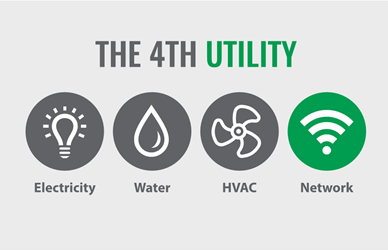For the past decade, a significant initiative in the information and communications technology (ICT) industry has been establishing the network as a critical – and the fourth - utility. Historically, building utilities were thought of as electricity, water, and HVAC; the network was more of an afterthought.

The rapid rise in our reliance both personally and professionally on connectivity has changed that argument. Access to the network for professionals across all industries is equally as important as access to electricity. Delivering care to patients, sorting boxes at distribution warehouses, assembling cars at a factory, conducting research in a lab, processing loans at a bank – none of these activities are completed today without the benefit of network access. It is valuable that owners and the design community provide more consideration to connectivity requirements today. Still, we are falling short of leveraging the network’s full capacity by simply labeling it a utility.
John Heskett’s work on design first articulated the importance of thinking beyond function in design. Design, according to Heskett, is a combination of utility and significance. A graphic designer must create a brochure that is easy to read. That’s utility. But to be effective, the brochure must also transmit ideas or emotions that the words alone cannot convey. That’s significance. A mobile phone has to make calls, text messages, and emails. That’s utility. It is the addition of features like managing personal health and wellness, providing entertainment, facilitating social connections, and more that give your mobile phone significance.
In our design of commercial, industrial, and institutional facilities today, we place great emphasis on function. While this has value, in a post-covid world, we need to recognize that utility will be widespread in the real estate market. Space will be abundant and accessible in all primary and secondary markets. As an example, corporate tenants like Airbnb and Twitter puta record 42 million square feet of space on the office market in the second and third quarters of 2020, increasing the total sublease space available in the US to its highest levels since 2005 (when this data first began being tracked). To make commercial spaces desirable again for tenants and occupants, our design framework needs to change to create built environments of significance.
THE ROLE OF SMART BUILDINGS
A Smart Building uses an “integrated set of technology, systems, and infrastructure that optimize building performance and occupant experience.” Very few, if any, of our commercial, industrial, or institutional real estate meets this definition today. In most facilities, building technologies like building management systems, lighting controls, energy management, electronic safety and security, audiovisual, and more have been designed and specified as individual systems and procured, installed, and commissioned in silos. As the rise in smart, network-connected systems increases in facilities, this design practice creates complexity and operations and maintenance challenges for owners once a facility is turned over. The design and construction process leaves owners with a disparate mix of individual building technologies, each of which has its own software platform, cloud services, cybersecurity requirements, programming needs, and data and reporting features.
The greater implication of this fractured approach to the design of building technologies is the lack of significance being delivered by the built environment today. Siloed systems cannot communicate with one another, process real-time data efficiently, and respond dynamically to the occupant’s needs. Contrast this to today’s smartphone: it knows your location, preferences, schedule, and history and makes suggestions in real-time what directions you need, what entertainment may benefit you, what groceries you need for tonight’s dinner, and more. It is the personalization we receive from our smartphones that deliver such significance.
Smart Buildings that are properly planned, designed, and constructed can serve occupants the same real-time personalization as a smartphone. When we speak with owners and architects today seeking to create a ‘connected’ experience for their properties, this is often what they refer to – the delivery of a more meaningful, personalized experience.
Our design process must evolve to unlock this potential in the built environment and create truly Smart Buildings. Here are three important changes you can make:
Adopt a Systems Thinking Mindset – Our review, design, and selection of building technologies today is too linear of a process. To create connected experiences, our facilities need to function as an interconnected ecosystem. When conceptualizing your property, think through the dependencies of how systems should work together and the outcomes you will realize as a result
Digital Experience Visioning – Spend the time to define the type of digital experience you want occupants to have while they are on your property. This means taking the time to experience your property beyond what you see in BIM models and visualizations; walk through where you see different occupant groups interacting with technology and how that technology will enhance their experience if designed and executed correctly.
Define Systems Integration Requirements –The traditional approach to design creates siloed building systems. To create more personalized experiences for occupants, enable better utilization of data, and use technologies like machine learning and artificial intelligence, building technologies need to be designed to integrate. This includes defining things like how data will flow between systems, what protocols will be leveraged, where data will be stored, and how systems and devices will be named.
Smart Buildings offer the great potential to help our built environments transcend simple utility. To do so, owners and design professionals need to think beyond function– to understand how a connected experience can transform the value to occupants to one of significance.